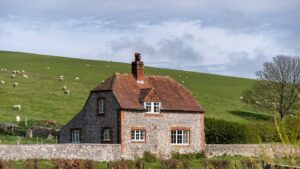Future building

This article was originally published by Property Investor News
The last 18 months have had an unprecedented impact on the way we go about our day to day lives. The biggest shock now, however, is perhaps that the fortune tellers predicting the “death of the city” were pretty far from the mark. It seems that central London is seeing a return to at least some of its pre-Covid habits – with tubes getting back to 70 per cent of their pre-pandemic ridership and residential rental prices in prime London locations seeing healthy growth in the last quarter.
There can be no doubt, however, that home working provides a freedom to people that five days in the office will never offer – with numerous studies showing employees are determined to embrace a hybrid of office and home working on a long-term basis. While offices are reopening, employers are embracing the lower costs of running much reduced office capacities and we are seeing the transition of offices from a “desk and chain” to becoming hubs for more specific tasks and interactions on only limited days, with home-working taking place for the remainder of the week. Many property professionals see these changes as here to stay and predict they will drive market movement for years to come.
In placemaking terms, it seems the 20th Century divide between residential and office districts are blurring, with the demand placed on the spaces we live in resulting in unique opportunities for our built environment to innovate and enhance. Moving forward, it seems increasingly likely that Britain’s cities will embrace the idea of “legacy developments” to build community-centric and sustainable living areas in order to retain urban footfall, combining spaces for living, working and leisure.
The sector, however, must be wary of past mistakes. Covid-19 has arguably seen the greatest change in working habits since the post-war boom in Britain, but in a fraction of the time. Britain’s “New Towns” built from the green fields of the 1940s and 1960s were praised as the solution to the booming post-war population spilling from congested metropolitan areas. However, new town developments were often cheap, built quickly and designed exclusively around the motor car. The result was high density, poor-quality housing with limited and unsustainable retail facilities, separated from other communities by major roadways. In many cases, the construction of new towns was tainted by a desire to create what planners thought people should want in a futuristic new town, rather than considering the real needs of the public.
In comparison, legacy developments seek to combine the vision of architects, developers, community leaders and the public to create developments tied to sustainability, quality and longevity, all with a focus on the public realm. Indeed, legacy developments seem to tick all the boxes to capitalise on current opportunities presented by new hybrid working practices. Adapting the principles underlying placemaking projects outside of London which look to create a legacy as well as profit over the long term, can provide what many thought they had to leave the urban landscape to find when buying new build properties in cities – beautiful indoor and outdoor space with increased local amenities, community initiatives and involvement.
It is clear that beneficiaries of legacy developments are not constrained to their residents either. Legacy developments can be an optimum choice for developers, investors and planners. It is no secret that pandemic-incurred losses in the sector were high and, for those seeking to recoup these losses, they provide an opportunity for “patient capital” to be deployed. Legacy development’s sustainability schemes bolster the ESG credentials essential for investment portfolios, with these credentials also meaning local authorities are more likely to buy-in to their plans. Following COP-26, the direction of travel is clearer than ever, and developers don’t want to be playing catch up where ESG commitments are paramount.
Indeed, at Glasgow this week the “COP-26 House” was revealed – a zero-carbon timber frame house designed to showcase how houses can be constructed with minimal environmental impact. The key to the “COP-26 House” is that environmentally friendly homes can be both affordable and desirable, built with materials and trade skills readily available today. Importantly, legacy developments seek to incorporate these key themes in both housing stock and the wider public realm. Net-zero construction strategies combat embodied carbon in the built environment and “gentle density” keeps a human friendly scale creating pleasant places. Reduced reliance on cars promises low-emission neighbourhoods, while concepts like “living streets” and even bee boxes promote and encourage biodiversity. Legacy developments already offer the template for the “COP-26 Community”.
The health of individuals and our planet is at the fore as we emerge from the Covid-19 pandemic at the same time as the global commitment to cutting carbon omissions is at an all-time high. Major changes are being heralded in the way we use our working and living spaces at both the grass roots level, within individual households, and on the international stage. Developments can no longer just be about meeting housing need. Sustainability, community and most crucially legacy must be at their core. We already have the template, all that’s left is to fully embrace and adapt it.
If you require further information about anything covered in this briefing, please contact Rebecca Price or your usual contact at the firm on +44 (0)20 3375 7000.
This publication is a general summary of the law. It should not replace legal advice tailored to your specific circumstances.
© Farrer & Co LLP, November 2021

